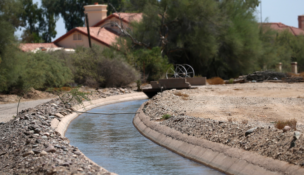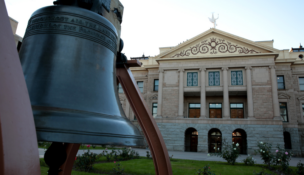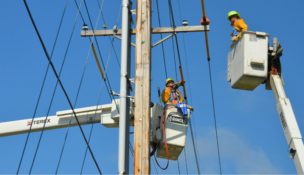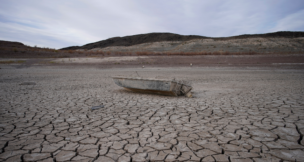Officials differ over forest thinning threat to goshawks
Arizona Capitol Reports Staff//December 7, 2007//[read_meter]
Officials differ over forest thinning threat to goshawks
Arizona Capitol Reports Staff//December 7, 2007//[read_meter]
Northern goshawks are about lose their cover — or a good part of it, according to Arizona Game and Fish and a Western conservation group.
Goshawks are engineered for forests with dense canopies. They have a short wing span that allows them to maneuver through thick stands when hunting for prey.
The U.S. Forest Service has guidelines designed to protect goshawks in national forests. These guidelines require a percentage of canopy be preserved in areas subject to logging or thinning.
But the agency’s latest proposal for carrying out these guidelines drew objections from the Arizona Game and Fish Department as well as the Center for Biological Diversity.
Where clearing is allowed, goshawk forest canopy could be reduced to 10 percent, a lower figure than current guidelines allow said Ron Sieg, Game and Fish regional supervisor in Flagstaff.
“Our perception is, that’s probably not enough density to make the area desirable for goshawks,” Sieg said.
In addition, he said, goshawk prey relies on canopy cover for habitat.
“There’s 14 species of prey that the goshawk depends on for food,” Sieg said.
The goshawk also depends on forest cover for nesting, he said.
The Forest Service rolled out its goshawk policy in June, said Taylor McKinnon, Flagstaff-based public lands advocate for the Center for Biological Diversity, a conservation group. The agency had crafted the decision months before, he said.
He agrees with Sieg that the new policy would harm the goshawk, which, he said, has been in decline.
The center’s objection to the new policy put a temporary halt to a thinning project on 10,000 acres in the Coconino National Forest northeast of Flagstaff.
In clearing trees, Sieg said, the Forest Service proposes to gauge canopy cover over much smaller areas — by groups instead of stands of trees, he said. A group might cover just an acre of trees, whereas a stand can cover up to 1,000 acres. For example, if rules call for a 40 percent cover — and the stand has only a 40 percent canopy cover to begin with — no more trees would be cut.
But under the new proposal, each group that had trees could be thinned down to a 40 percent cover. If you count the areas with no trees to begin with, the stand could be reduced to a 10 percent canopy.
“Over the course of the whole area, you’ll have a much denser forest than you’ll have with the current proposal,” Sieg said.
McKinnon compared it to a checkerboard in which no black squares are counted.
Forest Services officials disagreed with the goshawk proposal’s effect.
“First off, there’s no intent on the part of the Forest Service to jeopardize or threaten the goshawk,” said Pat Jackson, director of appeals and litigation for the agency’s Region 3, which oversees 11 national forests in Arizona and New Mexico.
But Game and Fish, as well as the center, also criticized the Forest Service for making the decision without public comment.
“They made the reinterpretation without any input from the public, and so, as a department, we never got an opportunity to comment,” Sieg said.
The center seconded the criticism.
“The wildlife agencies were specifically excluded from the process,” McKinnon said.
But Forest Service officials say they did not change the canopy guidelines regarding the goshawk. Jackson said the Forest Service was clarifying the Southwest region goshawk guidelines that date back to 1996.
The decision was simply a “white paper” clarifying the goshawk guidelines, Jackson said. It was not change in direction, he added. The clarification, he said, did not require public input or a review under the National Environmental Policy Act.
But Sieg at Game and Fish disagreed: “We think it’s such a dramatic change from the 1996 interpretation, that it should have gone out to the public.”
But Jackson suggested the decision was simply a how-to manual for district foresters.
“We developed an implementation guide that would allow us to make sure that the direction that’s in the forest plans is complied with at the project level,” Jackson said.
The first project to implement the new policy drew a formal objection from the Center for Biological Diversity. It’s known as the Jack Smith-Schultz Fuel Reduction project. Its aim, in part, is to thin trees that could threaten development on the forest’s edge.
Because of the center’s objection, the district ranger overseeing the project was asked by his supervisors to reconsider it, Jackson said.
“We basically asked the ranger to go back and look at the project, possibly reanalyze it and make sure that it’s consistent with the forest plan,” he said.
Jackson added that the Forest Service did not try to hide the goshawk policy as when it proposed the Jack Smith project. Officials at Game and Fish were told about the goshawk guidelines, as newly implemented.
Sieg of Game and Fish agrees, up to a point.
“They did have field trips this summer to allow us to go out and see how they were going to apply it, but we didn’t get any input into the original interpretation,” Sieg said.
The state agency formally objected to the new canopy scheme in a June 5 letter to Gene Waldrip, ranger for the Coconino National Forest Peaks District in Flagstaff.
“The department reserves some concern about the proposed shift in how the FS (Forest Service) plans to reduce overall tree canopy cover within treated areas,” wrote Sarah Lantz, Game and Fish urban wildlife planner in Flagstaff.
Jackson, with the Forest Service regional office, said the only matter in dispute is whether the district ranger had correctly applied the guidelines in the Jack Smith project.
The guidelines — as applied — aren’t meant to reduce goshawk canopy, Jackson said, “although in some projects that may be the case. We have to look at the specific projects.”
The center’s McKinnon, however, said the underlying objection to Jack Smith is not consistency with forest plans but the broader application of goshawk guidelines.
“Every project in which the Forest Service applies this new rule, we’re going to challenge it in both states, Arizona and New Mexico,” he said.
McKinnon said the challenges might well lead to court.
Legal action, he said, brought about the 1996 goshawk guidelines in the first place, McKinnon said. Conservation groups had originally sought to get the goshawk listed as a threatened species.
The Forest Service now considers the goshawk a sensitive species, which means managing it so it doesn’t become threatened. Arizona Game and Fish lists the goshawk as a “species of concern.”
Sieg, the agency’s regional supervisor, said — except for the goshawk dispute — Game and Fish remains on good terms with the Forest Service.
“It’s just one issue we don’t agree on,” Sieg said.
















